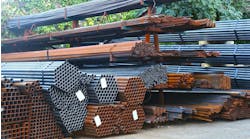Latest from Home
Sponsored
THE PRICES OF industrial metals used by manufacturers gained strength in January, leading some analysts to believe that the industrial market would rebound in 2002.
The increases in prices of copper, aluminum, nickel and lead – which actually began to rise in November – could signal that manufacturers are starting to boost production. The prices of these metals dropped during the first 10 months of last year as the economy softened.
Veteran industry observer Ed Scott, who publishes the P-H-C-P Intelligence Report, said that he foresees growth in wholesalers’ sales of industrial pipe, valves and fittings in the third quarter of this year. That will follow flat sales in the second quarter after a soft first quarter, he reported in his Jan. 3 newsletter.
Overall, the wholesaler market for industrial MRO and new projects should grow by 4% in 2002, Scott told board members of the American Supply Association in a meeting in January in California. By specific market, oil and gas production should lead the way with 10% growth, followed by a 9% hike in water supply and sewage disposal projects.
Power generation should grow by 5%, largely fueled by projects in California, Scott said. While he added that he expects the pulp-and-paper market to be flat and chemical processing to grow just 1% to 2%, the refining and petrochemical sector could go up 3% to 5%.
“The growth in that sector will be more the tweaking of refineries than the building of new ones,” Scott told CONTRACTOR in late January.
Consultant FMI predicts that improvements to existing facilities will overtake new construction not only with refineries but also with industrial plants in general.
“Industrial building improvements equaled nearly two-thirds of total new industrial construction, revealing the increasing attractiveness of revamping previously built industrial buildings instead of constructing entirely new structures,” FMI reported, citing previous-year numbers.
The physical cycle of supply and demand and the financial cycle of capital flows are major drivers to when and where industrial buildings are built, said Glenn Mueller, professor at John Hopkins University Real Estate Institute and real estate investment strategist for Legg Mason Inc. Both cycles will affect how well the construction industry does in the upcoming months, Mueller told attendees at CMD’s sixth Annual North American Construction Forecast conference Oct. 16 in Washington.
The supply and demand cycle is local in nature, Mueller said, and different U.S. cities are at different points in their cycles. In the industrial market, none of the nation’s major cities had entered the recession stage at the end of the second quarter of 2001.
Still, although physical market cycles are local, some general macroeconomic trends will affect the entire building industry in the early 2000s. On the demand side, population growth at a rate of about 2.4 million people every year for the next decade will increase demand for all property types, Mueller said.
On the supply side, construction labor had been the hardest to find in 2000, Mueller said, but that situation eased rapidly in 2001. Meanwhile, materials costs are increasing and the nation’s infrastructures have not been expanded, which restricts new approvals and thus new construction.
One trend that should continue the next few years is that more efficient capital markets have matched supply levels more closely to demand levels, following two decades of mismatch.

